Irrigation Supply and Demand, Land Use/Cover Change and Future Projections of Climate, in Indus Basin Irrigation System, Pakistan
Abstract
1. Introduction
2. Materials and Methods
2.1. Study Area
2.2. Data Collection and Analysis
2.3. WEAP Model Development
2.4. Scenarios Developed in WEAP Modeling Framework
2.5. Model Calibration
3. Results
3.1. Simulated and Observed Streamflow
3.2. Model Calibration and Validation
3.3. WEAP Model Simulations to Estimate Canal Water Deficit
3.4. Canal Catchment Reliability
3.5. Future Water Allocation Scenarios
4. Discussion
5. Proposed Strategies and Conclusions
- The annual water demand for the UJC and LJC canal catchment was found to be 4086, and 10,607 million cubic meters (MCM), and the yearly water shortage was found to be 2197.2 and 8540.6 MCM with catchment reliability of 61 and 46%, respectively. Currently, available surface water is not sufficient to meet the demand for agricultural water;
- The LJC command area is more sensitive to water scarcity, as this area is more than twice the UJC command area with less LJC design discharge as compared to UJC;
- It is concluded that by adopting scenario 3 (irrigation efficiency improvement through implementation of high-efficiency irrigation systems, canal lining, reduction and replacement of high delta crops with low delta crops), the system reliability can be maximized up to 84% and 54% for the UJC and LJC command areas, respectively;
- Future climate changes may double the unmet demand, and particularly the LJC command area is seriously going to face water scarcity situations if not properly managed. Additionally, WEAP can be used as a useful hydrological modeling tool for efficient water resources management, and planning for the researchers and respective guidelines for policymakers will have fruitful outcomes.
Author Contributions
Funding
Institutional Review Board Statement
Informed Consent Statement
Data Availability Statement
Acknowledgments
Conflicts of Interest
References
- Archer, D.R.; Forsythe, N.D.; Fowler, H.; Shah, S.M. Sustainability of water resources management in the Indus Basin under changing climatic and socio economic conditions. Hydrol. Earth Syst. Sci. 2010, 14, 1669–1680. [Google Scholar] [CrossRef]
- Culas, R.J.; Baig, I.A. Impacts of irrigation water user allocations on water quality and crop productivity: The lcc irrigation system in pakistan. Irrig. Drain. 2020, 69, 38–51. [Google Scholar] [CrossRef]
- Moriana, A.; Villalobos, F.; Fereres, E. Stomatal and photosynthetic responses of olive (Olea europaea L.) leaves to water deficits. Plant Cell Environ. 2002, 25, 395–405. [Google Scholar] [CrossRef]
- Tognetti, R.; D’Andria, R.; Lavini, A.; Morelli, G. The effect of deficit irrigation on crop yield and vegetative development of Olea europaea L. (cvs. Frantoio and Leccino). Eur. J. Agron. 2006, 25, 356–364. [Google Scholar] [CrossRef]
- Smith, M. The application of climatic data for planning and management of sustainable rainfed and irrigated crop production. Agric. For. Meteorol. 2000, 103, 99–108. [Google Scholar] [CrossRef]
- National Water Policy. Ministry of Water Resources: Islamabad, Pakistan. 2018. Available online: https://mowr.gov.pk/index.php/national-water-policy-2018/ (accessed on 2 March 2020).
- Archer, D. Contrasting hydrological regimes in the upper Indus Basin. J. Hydrol. 2003, 274, 198–210. [Google Scholar] [CrossRef]
- Fahim, M.A. Impact of Water Scarcity on Food Security at Macro Level in Pakistan. 2011. Available online: https://mpra.ub.uni-muenchen.de/35758/ (accessed on 5 March 2020).
- Latif, M.; Pomee, M.S. Irrigation management turnover: An option for improved utilization of limited water resources in Pakistan. Irrigation and Drainage. J. Int. Comm. Irrig. Drain. 2003, 52, 261–272. [Google Scholar] [CrossRef]
- Rinaudo, J.-D.; Strosser, P.; Rieu, T. Linking water market functioning, access to water resources and farm production strategies: Example from Pakistan. Irrig. Drain. Syst. 1997, 11, 261–280. [Google Scholar] [CrossRef]
- Hussain, I. Pro-Poor Intervention Strategies in Irrigated Agriculture in Asia: Poverty in Irrigated Agriculture: Issues, Lessons, Options and Guidelines: Bangladesh, China, India, Indonesia, Pakistan and Vietnam. Final Synthesis Report; International Water Management Institute. 2005. Available online: http://www.iwmi.cgiar.org/propoor/files/ADB_Project/Country%20briefs/Synthesis-lessons%20and%20guidelines.pdf (accessed on 5 March 2020).
- Bandaragoda, D.J. Limits to donor-driven water sector reforms: Insight and evidence from Pakistan and Sri Lanka. Hydrol. Res. 2006, 8, 51–67. [Google Scholar] [CrossRef]
- Tanaka, S.K.; Zhu, T.; Lund, J.R.; Howitt, R.E.; Jenkins, M.W.; Pulido-Velazquez, M.; Tauber, M.; Ritzema, R.S.; Ferreira, I.C. Climate Warming and Water Management Adaptation for California. Clim. Chang. 2006, 76, 361–387. [Google Scholar] [CrossRef]
- Khalid, P.D.I.; Khan, M.A. Water Scarcity-A Major Human Security Challenge to Pakistan. South Asian Stud. 2020, 31, 525–539. [Google Scholar]
- Sandoval-Solis, S.; McKinney, D.C. Integrated Water Management for Environmental Flows in the Rio Grande. J. Water Resour. Plan. Manag. 2014, 140, 355–364. [Google Scholar] [CrossRef]
- Allen, R.G.; Pereira, L.S.; Raes, D.; Smith, M. Crop Evapotranspiration-Guidelines for Computing Crop Water Requirements-FAO Irrigation and Drainage Paper 56; FAO: Rome, Italy, 1998. [Google Scholar]
- Luo, X.; Wang, K.; Jiang, H.; Sun, J.; Zhu, Q. Estimation of land surface evapotranspiration over the Heihe River basin based on the revised three-temperature model. Hydrol. Process. 2011, 26, 1263–1269. [Google Scholar] [CrossRef]
- Zhuang, Q.; Wu, B. Estimating Evapotranspiration from an Improved Two-Source Energy Balance Model Using ASTER Satellite Imagery. Water 2015, 7, 6673–6688. [Google Scholar] [CrossRef]
- Li, J.; Zhu, T.; Mao, X.; Adeloye, A.J. Modeling crop water consumption and water productivity in the middle reaches of Heihe River Basin. Comput. Electron. Agric. 2016, 123, 242–255. [Google Scholar] [CrossRef]
- Li, S.; Kang, S.; Zhang, L.; Zhang, J.; Du, T.; Tong, L.; Ding, R. Evaluation of six potential evapotranspiration models for es-timating crop potential and actual evapotranspiration in arid regions. J. Hydrol. 2016, 543, 450–461. [Google Scholar] [CrossRef]
- Sechi, G.M.; Sulis, A. Water System Management through a Mixed Optimization-Simulation Approach. J. Water Resour. Plan. Manag. 2009, 135, 160–170. [Google Scholar] [CrossRef]
- Perera, B.; James, B.; Kularathna, M. Computer software tool REALM for sustainable water allocation and management. J. Environ. Manag. 2005, 77, 291–300. [Google Scholar] [CrossRef]
- Andreu, J.; Capilla, J.; Sanchís, E. AQUATOOL, a generalized decision-support system for water-resources planning and operational management. J. Hydrol. 1996, 177, 269–291. [Google Scholar] [CrossRef]
- Fredericks, J.W.; Labadie, J.W.; Altenhofen, J.M. Decision Support System for Conjunctive Stream-Aquifer Management. J. Water Resour. Plan. Manag. 1998, 124, 69–78. [Google Scholar] [CrossRef]
- Jha, M.K.; Gupta, A.D. Application of Mike Basin for water management strategies in a watershed. Water Int. 2003, 28, 27–35. [Google Scholar] [CrossRef]
- Yates, D.; Sieber, J.; Purkey, D.; Huber-Lee, A. WEAP21—A demand-, priority-, and preference-driven water planning model: Part 1: Model characteristics. Water Int. 2005, 30, 487–500. [Google Scholar] [CrossRef]
- Mugatsia, E.A. Simulation and Scenario Analysis of Water Resources Management in Perkerra Catchment Using WEAP Model. Master’s Thesis, Department of Civil and Structural Engineering, School of Engineering, Moi University, Nairobi, Kenya, December 2010. [Google Scholar]
- Blanco-Gutiérrez, I.; Varela-Ortega, C.; Flichman, G. Cost-effectiveness of groundwater conservation measures: A multi-level analysis with policy implications. Agric. Water Manag. 2011, 98, 639–652. [Google Scholar] [CrossRef]
- Ahmed, N.; Mahmood, S.; Munir, S. Estimation of potential and actual crop evapotranspiration using Weap model. Sci. Int. 2015, 27, 4373–4377. [Google Scholar]
- Ahmed, N.; Wang, G.; Booij, M.J.; Oluwafemi, A.; Hashmi, M.Z.-U.; Ali, S.; Munir, S. Climatic Variability and Periodicity for Upstream Sub-Basins of the Yangtze River, China. Water 2020, 12, 842. [Google Scholar] [CrossRef]
- Ahmed, N.; Wang, G.-X.; Oluwafemi, A.; Munir, S.; Hu, Z.-Y.; Shakoor, A.; Imran, M.A. Temperature trends and elevation dependent warming during 1965–2014 in headwaters of Yangtze River, Qinghai Tibetan Plateau. J. Mt. Sci. 2020, 17, 556–571. [Google Scholar] [CrossRef]
- Marhaento, H.; Booij, M.J.; Ahmed, N. Quantifying relative contribution of land use change and climate change to streamflow alteration in the Bengawan Solo River, Indonesia. Hydrol. Sci. J. 2021, 66, 1059–1068. [Google Scholar] [CrossRef]
- Liu, Y.; Chen, Q.; Ge, Q.; Dai, J.; Qin, Y.; Dai, L.; Zou, X.; Chen, J. Modelling the impacts of climate change and crop man-agement on phenological trends of spring and winter wheat in China. Agric. For. Meteorol. 2018, 248, 518–526. [Google Scholar] [CrossRef]
- Moat, J.; Gole, T.W.; Davis, A.P. Least concern to endangered: Applying climate change projections profoundly influences the extinction risk assessment for wild Arabica coffee. Glob. Chang. Biol. 2018, 25, 390–403. [Google Scholar] [CrossRef]
- Ashraf, M.Q.; Khan, S.A.; Khan, R.; Iqbal, M.W. Determinants of Adaptation Strategies to Climate Change by Farmers in District Sargodha, Pakistan. Int. J. Econ. Environ. Geol. 2019, 9, 16–20. [Google Scholar]
- Mahmood, G.G.; Rashid, H.; Anwar, S.; Nasir, A. Evaluation of Climate Change Impacts on Rainfall Patterns in Pothohar Region of Pakistan. Water Conserv. Manag. 2019, 1–6. [Google Scholar] [CrossRef]
- Raza, M.H.; Bakhsh, A.; Kamran, M. Managing Climate Change for Wheat Production: An Evidence from Southern Punjab, Pakistan. J. Econ. Impact 2019, 1, 48–58. [Google Scholar] [CrossRef]
- Mehta, V.K.; Haden, V.R.; Joyce, B.A.; Purkey, D.R.; Jackson, L.E. Irrigation demand and supply, given projections of climate and land-use change, in Yolo County, California. Agric. Water Manag. 2013, 117, 70–82. [Google Scholar] [CrossRef]
- Cheema, M.; Immerzeel, W.; Bastiaanssen, W. Spatial Quantification of Groundwater Abstraction in the Irrigated Indus Basin. Ground Water 2013, 52, 25–36. [Google Scholar] [CrossRef]
- Cheema, M. Understanding Water Resources Conditions in Data Scarce River Basins Using Intelligent Pixel Information, Case: Transboundary Indus Basin. Doctoral Thesis, Delft University of Technology, Delft, The Netherlands, 29 May 2012. [Google Scholar]
- Dehghanipour, A.; Zahabiyoun, B.; Schoups, G.; Babazadeh, H. A WEAP-MODFLOW surface water-groundwater model for the irrigated Miyandoab plain, Urmia lake basin, Iran: Multi-objective calibration and quantification of historical drought impacts. Agric. Water Manag. 2019, 223. [Google Scholar] [CrossRef]
- Schneider, P.; Sander, B.O.; Wassmann, R.; Asch, F. Potential and versatility of WEAP model (Water Evaluation and Planning System) for hydrological assessments of AWD (Alternate Wetting and Drying) in irrigated rice. Agric. Water Manag. 2019, 224, 105559. [Google Scholar] [CrossRef]
- Aein, R.; Alizadeh, H. Integrated hydro-economic modeling for optimal design of development scheme of salinity affected irrigated agriculture in Helleh River Basin. Agric. Water Manag. 2021, 243, 106505. [Google Scholar] [CrossRef]
- Agarwal, S.; Patil, J.P.; Goyal, V.; Singh, A. Assessment of water supply–demand using water evaluation and planning (WEAP) model for Ur River watershed, Madhya Pradesh, India. J. Inst. Eng. Ser. A 2019, 100, 21–32. [Google Scholar] [CrossRef]
- Husain, S.A.; Rhyme, N.H.M. Decision Support Method for Agricultural Irrigation Scenarios Performance Using WEAP Model. Water Eval. Plan. 2020, 99–106. [Google Scholar] [CrossRef]
- Rajendran, M.; Gunawardena, E.; Dayawansa, N. Runoff Prediction in an Ungauged Catchment of Upper Deduru Oya Basin, Sri Lanka: A Comparison of HEC-HMS and WEAP Models. Int. J. Progress. Sci. Technol. 2020, 18, 121–129. [Google Scholar]
- Jabloun, M.; Sahli, A. WEAP-MABIA Tutorial: A Collection of Stand-Alone Chapters to Aid in Learning the WEAP-MABIA Module; Federal Institute for Geosciences and Natural Resources: Hannover, Germany, 2012.
- Esteve, P.; Varela-Ortega, C.; Blanco-Gutiérrez, I.; Downing, T.E. A hydro-economic model for the assessment of climate change impacts and adaptation in irrigated agriculture. Ecol. Econ. 2015, 120, 49–58. [Google Scholar] [CrossRef]
- Purkey, D.R.; Huber-Lee, A.; Yates, D.N.; Hanemann, M.; Herrod-Julius, S. Integrating a Climate Change Assessment Tool into Stakeholder-Driven Water Management Decision-Making Processes in California. Water Resour. Manag. 2006, 21, 315–329. [Google Scholar] [CrossRef]
- Santikayasa, I.P.; Babel, M.S.; Shrestha, S.; Jourdain, D.; Clemente, R.S. Evaluation of water use sustainability under future climate and irrigation management scenarios in Citarum River Basin, Indonesia. Int. J. Sustain. Dev. World Ecol. 2013, 21, 181–194. [Google Scholar] [CrossRef]
- Moriasi, D.N.; Arnold, J.G.; Van Liew, M.W.; Bingner, R.L.; Harmel, R.D.; Veith, T.L. Model evaluation guidelines for systematic quantification of accuracy in watershed simulations. Trans. ASABE 2007, 50, 885–900. [Google Scholar] [CrossRef]
- Ahmadaali, J.; Barani, G.-A.; Qaderi, K.; Hessari, B. Analysis of the Effects of Water Management Strategies and Climate Change on the Environmental and Agricultural Sustainability of Urmia Lake Basin, Iran. Water 2018, 10, 160. [Google Scholar] [CrossRef]
- Rashid, A. Impact of El-Nino on summer monsoon rainfall of Pakistan. Pak. J. Meteorol. 2004, 1, 35–43. [Google Scholar]
- Akhtar, M.; Ahmad, N.; Booij, M.J. Use of regional climate model simulations as input for hydrological models for the Hin-dukush-Karakorum-Himalaya region. Hydrol. Earth Syst. Sci. 2009, 13, 1075–1089. [Google Scholar] [CrossRef]
- Naheed, G.; Rasul, G. Investigation of rainfall variability for Pakistan. Pak. J. Meteorol. 2011, 7, 25–32. [Google Scholar]
- Aleem-ul-Hassan, M.; Haider, S.; Ullah, K. Diagnostic study of heavy downpour in the central part of Pakistan. Pak. J. Meteorol. 2010, 7, 53–61. [Google Scholar]
- Akhtar, I.U.H.; Athar, H. Climate-related inter-annual variability and long-term influence on wheat yield across canal-irrigated areas of Punjab, Pakistan. Theor. Appl. Clim. 2021, 143, 1195–1211. [Google Scholar] [CrossRef]
- Akhtar, I.U.H.; Athar, H. Water supply and effective rainfall impacts on major crops across irrigated areas of Punjab, Pakistan. Theor. Appl. Clim. 2020, 142, 1097–1116. [Google Scholar] [CrossRef]
- Sajjad, H.; Ghaffar, A. Observed, simulated and projected extreme climate indices over Pakistan in changing climate. Theor. Appl. Clim. 2018, 137, 255–281. [Google Scholar] [CrossRef]
- Awan, U.K.; Anwar, A.; Ahmad, W.; Hafeez, M. A methodology to estimate equity of canal water and groundwater use at different spatial and temporal scales: A geo-informatics approach. Environ. Earth Sci. 2016, 75, 1–13. [Google Scholar] [CrossRef]
- Parry, J.-E. The Vulnerability of Pakistan’s Water Sector to the Impacts of Climate Change: Identification of Gaps and Recommendations for Action; International Institute for Sustainable Development. 2016. Available online: https://www.iisd.org/publications/vulnerability-pakistans-water-sector-impacts-climate-change-identification-gaps-and (accessed on 23 April 2020).
- Fischer, G.; Tubiello, F.N.; van Velthuizen, H.; Wiberg, D. Climate change impacts on irrigation water requirements: Effects of mitigation, 1990–2080. Technol. Forecast. Soc. Chang. 2007, 74, 1083–1107. [Google Scholar] [CrossRef]
- Joyce, B.A.; Mehta, V.K.; Purkey, D.R.; Dale, L.L.; Hanemann, M. Modifying agricultural water management to adapt to cli-mate change in California’s central valley. Clim. Chang. 2011, 109, 299–316. [Google Scholar] [CrossRef]
- Hassan, D.; Bano, R.; Burian, S.; Ansari, K. Modeling water demand and supply for future water resources management. Int. J. Sci. Eng. Res. 2017, 8, 1745–1750. [Google Scholar]
- Masih, I.; Giordano, M. Constraints and opportunities for water savings and increasing productivity through Resource Con-servation Technologies in Pakistan. Agric. Ecosyst. Environ. 2014, 187, 106–115. [Google Scholar]
- Karimi, P.; Bastiaanssen, W.G.M.; Molden, D.; Cheema, M.J.M. Basin-wide water accounting based on remote sensing data: An application for the Indus Basin. Hydrol. Earth Syst. Sci. 2013, 17, 2473–2486. [Google Scholar] [CrossRef]
- Qureshi, A.S.; Gill, M.A.; Sarwar, A. Sustainable groundwater management in Pakistan: Challenges and opportunities. Irrig. Tion Drain. J. Int. Comm. Irrig. Drain. 2010, 59, 107–116. [Google Scholar] [CrossRef]
- Alfarra, A.; Benedict, E.K.; Hötzl, H.; Sader, N.; Sonneveld, B. Modeling Water Supply and Demand for Effective Water Management Allocation in the Jordan Valley. J. Agric. Sci. Appl. 2012, 1, 1–7. [Google Scholar] [CrossRef]
- Hao, L.; Sun, G.; Liu, Y.; Qian, H. Integrated Modeling of Water Supply and Demand under Management Options and Climate Change Scenarios in Chifeng City, China. JAWRA J. Am. Water Resour. Assoc. 2015, 51, 655–671. [Google Scholar] [CrossRef]
- Zhu, T.; Ringler, C.; Iqbal, M.M.; Sulser, T.B.; Goheer, M.A. Climate change impacts and adaptation options for water and food in Pakistan: Scenario analysis using an integrated global water and food projections model. Water Int. 2013, 38, 651–669. [Google Scholar] [CrossRef]
- Shakoor, U.; Saboor, A.; Baig, I.; Afzal, A.; Rahman, A. Climate variability impacts on rice crop production in Pakistan. Pak. J. Agric. Res. 2015, 28, 19–27. [Google Scholar]
- Berredjem, A.-F.; Hani, A. Modelling current and future supply and water demand in the northern region of the Seybouse Valley. J. Water Land Dev. 2017, 33, 31–38. [Google Scholar] [CrossRef][Green Version]
- Arsiso, B.K.; Tsidu, G.M.; Stoffberg, G.H.; Tadesse, T. Climate change and population growth impacts on surface water supply and demand of Addis Ababa, Ethiopia. Clim. Risk Manag. 2017, 18, 21–33. [Google Scholar] [CrossRef]


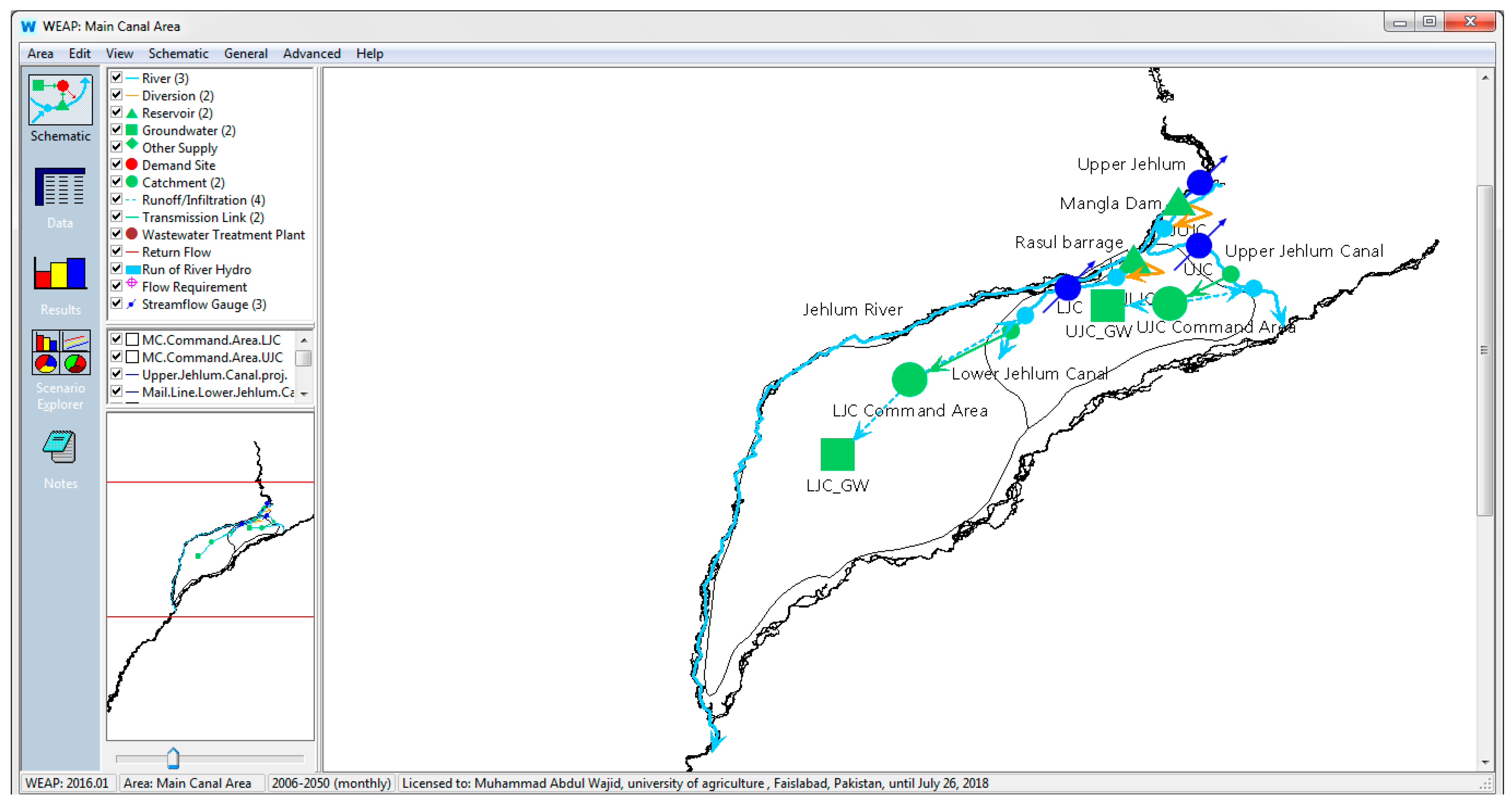
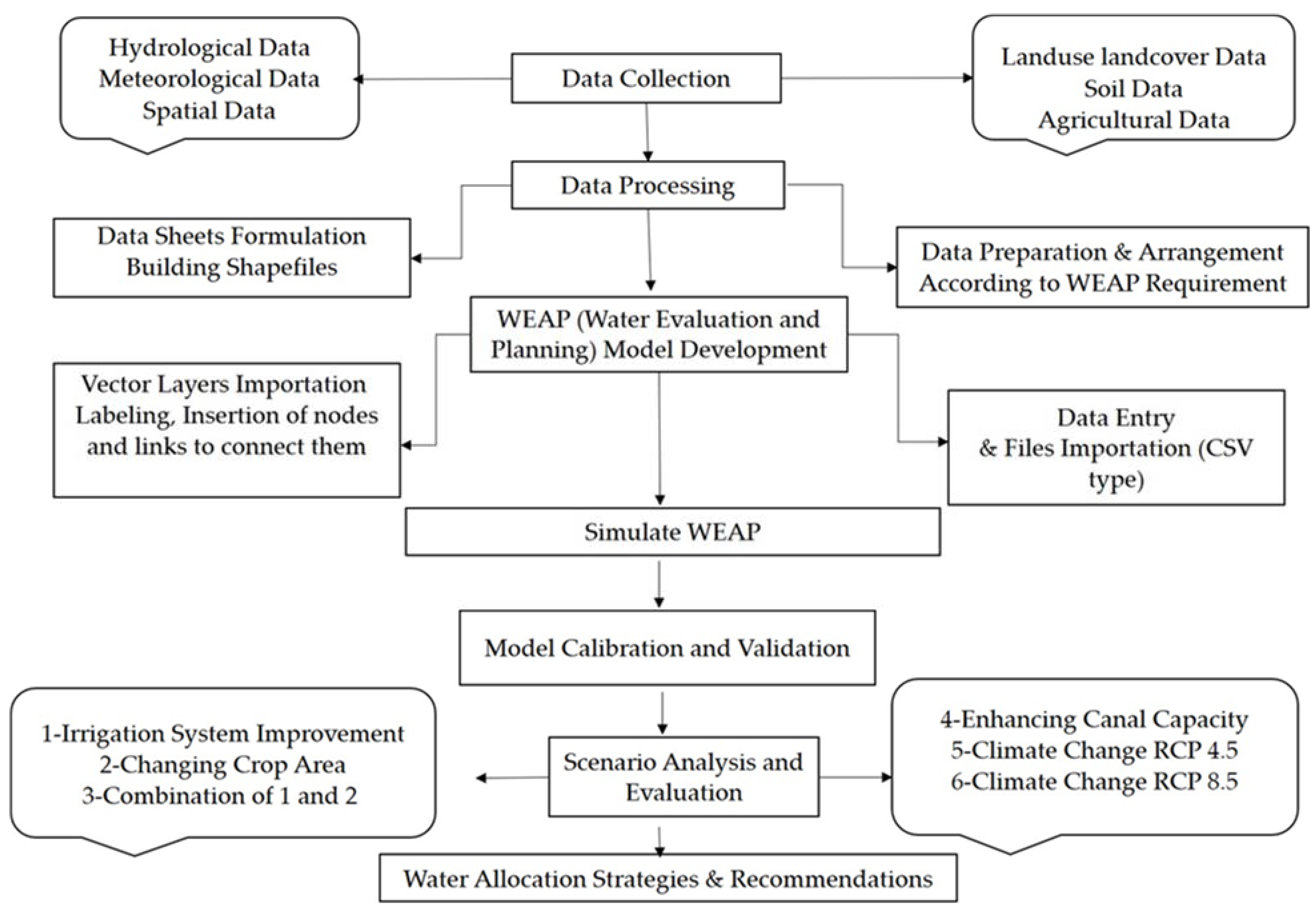
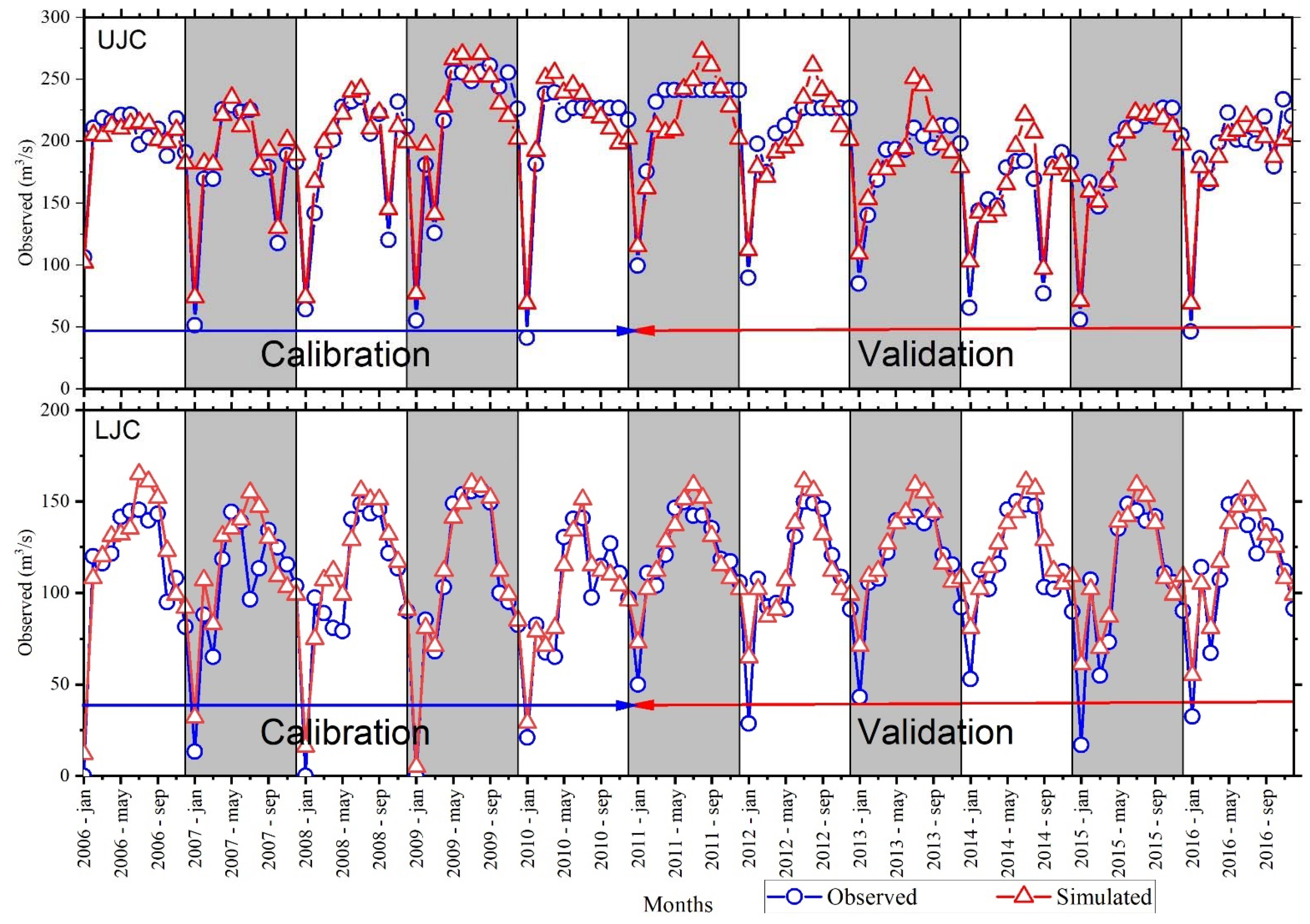
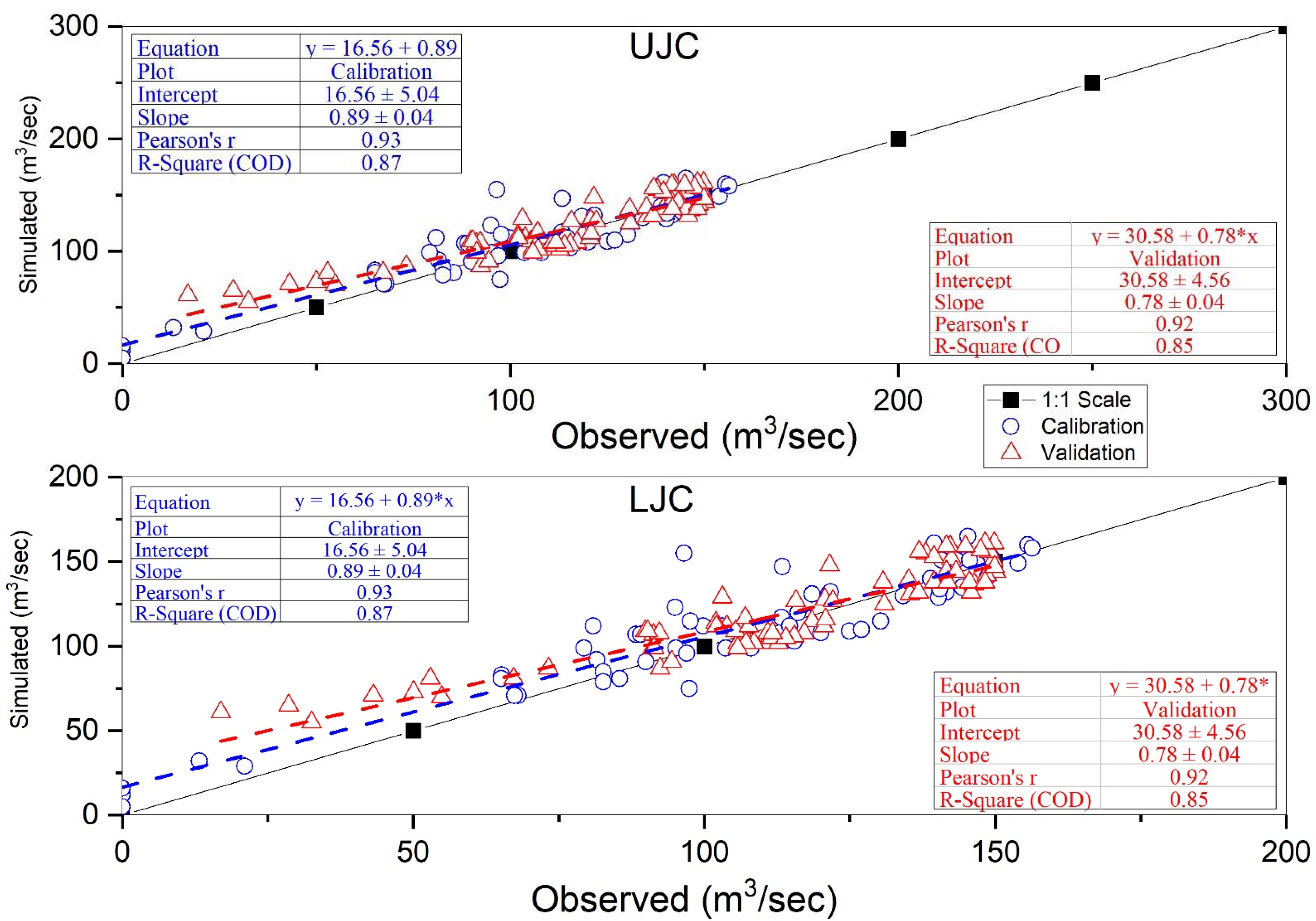

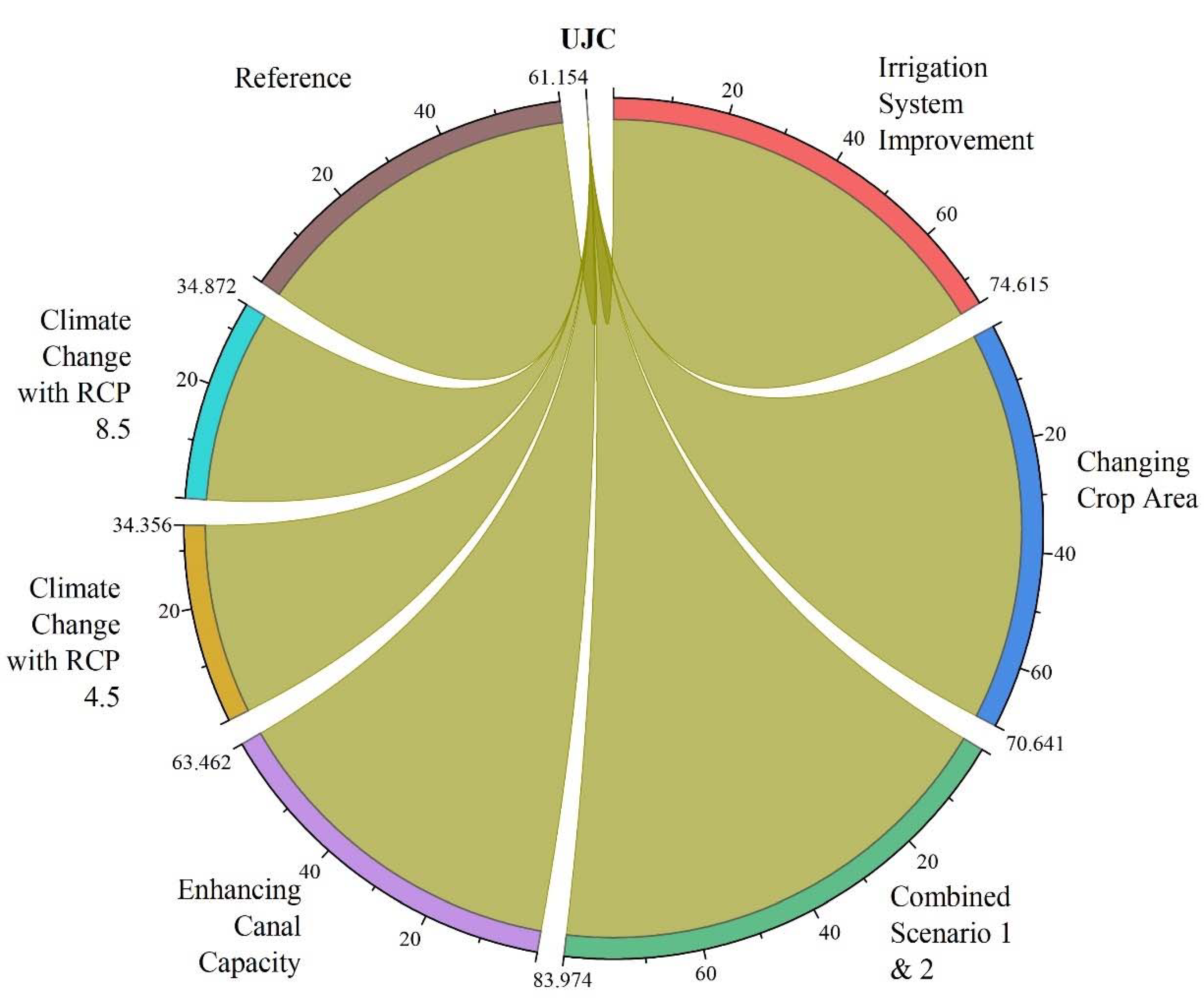
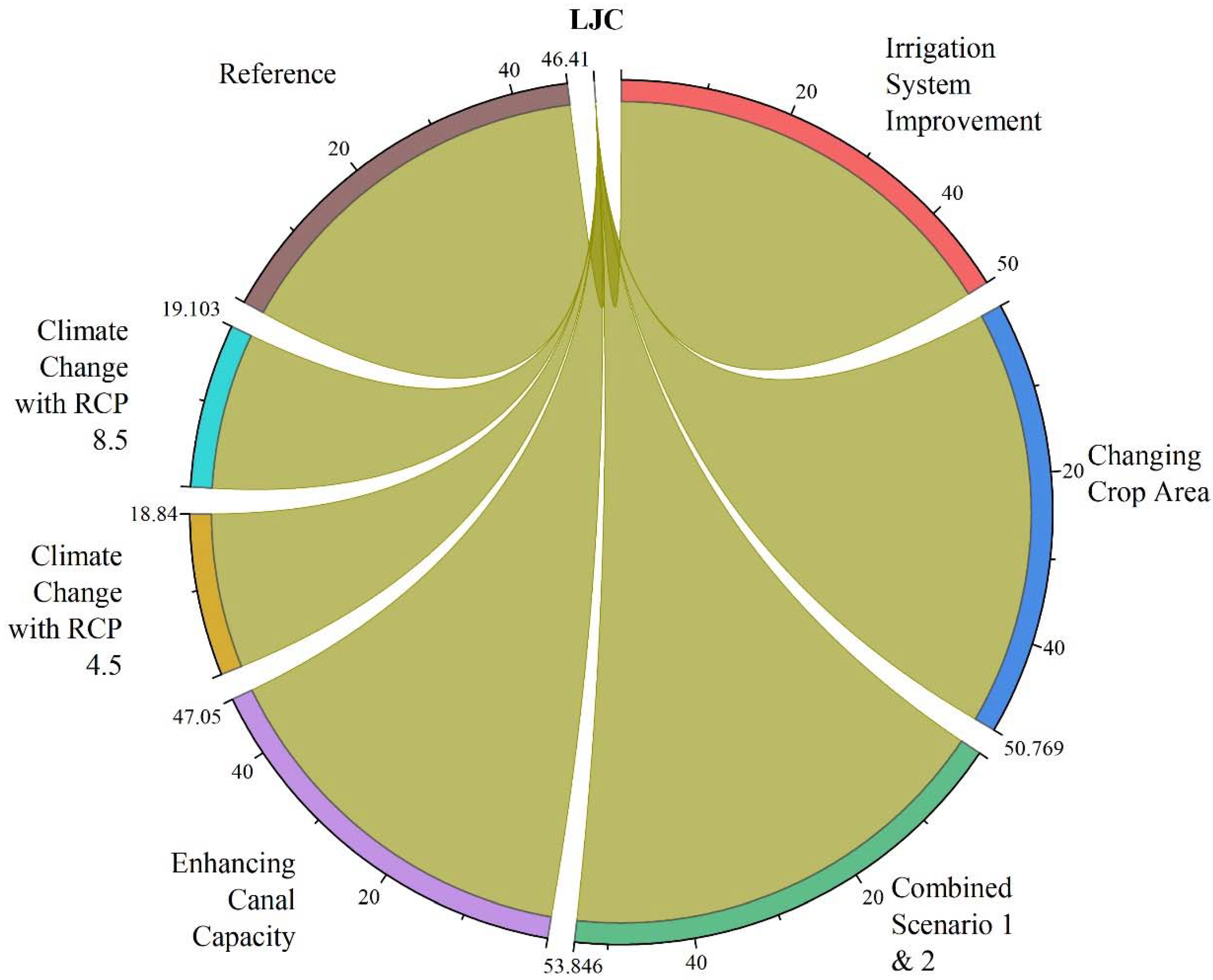
| Serial No. | Data Type & Description | Frequency/Type | Duration | Data Source |
|---|---|---|---|---|
| 1 | Discharge data of Mangla Dam, Jhelum River, LJC and UJC | Daily Basis | 2006–2016 | Punjab Irrigation Department (PID), Lahore |
| 2 | Climatic Data (Max. temperature and Min. temperature, Rainfall, Wind Speed Humidity, Sunshine Hours and Latitude, Longitude) | Monthly Basis | 2006–2016 | Pakistan Meteorological Department (PMD) |
| 3 | Soil Data (Soil type of Upper Jhelum Canal (UJC) & Lower Jhelum Canal (LJC) command area) | Raster file | Soil map for both command areas in Chaj Doab | Harmonized World Soil Database V 1.2 (HWSD). Food and Agriculture Organization (FAO) of the United Nations. http://webarchive.iiasa.ac.at/Research/LUC/External-World-soil-database (accessed on 21 October 2019) |
| 4 | Land use & land Cover Data | Raster file for Rabi & Kharif season | 2013–2014 | Land use/cover data for Rabi 2013-14 and Kharif 2013 was derived from Landsat 8 which was also validated by Cheema [40], see Figure 2 |
| 5 | Agricultural data (Crop Type, Crop Planting Month & date, harvesting date, Crop Co-efficient, Crop Height, Root Depth, Growth Stages Length, Crop Season Length, Vegetative Fraction Covered | Yearly Basis | 2006–2016 | Yearly online published Reports (concerned Agri. Departments) & FAO. 56 |
| 6 | Shapefiles (River Jhelum, UJC & LJC and its Command areas) | - | - | Punjab Irrigation Department, (PID), Lahore. |
| Scenarios | Strategies Implementation |
|---|---|
| Scenario-1: (Irrigation System Improvement) | Increase in irrigation efficiency (85%) using drip and sprinkler technologies, and Seepage losses reduction through canal lining (50%) |
| Scenario-2: (Changing Crop Area) | Reduction in area of High delta crop and replacement with low water delta crops (50%) |
| Scenario-3: (Combination of Scenario 1 and 2) | Irrigation Efficiency (85%), Seepage losses reduction (50%), area reduction of high delta crops and replacement (50%) |
| Scenario-4: Canal Capacity Enhancement | Increasing canal capacity through canal maintenance i.e., silt removal and increase in canal diversions (20%) |
| Scenario-5: Climate Change with RCP 4.5 | Future climate change impact (Temperature & Rainfall data) with RCP 4.5 up to 2070 |
| Scenario-6: Climate Change with RCP 8.5 | Future climate change impact (Temperature & Rainfall data) with RCP 8.5 up to 2070 |
| Evaluation Criterion | Calibration | Validation | ||
|---|---|---|---|---|
| Upper Jhelum Canal (UJC) | Lower Jhelum Canal (LJC) | Upper Jhelum Canal (UJC) | Lower Jhelum Canal (LJC) | |
| NSE | 0.91 | 0.83 | 0.8 | 0.83 |
| PBIAS | −2.92 | −7.01 | −1.48 | −2.97 |
| R2 | 0.93 | 0.87 | 0.83 | 0.85 |
| Scenario Types | Change in Reliability (%) | |
|---|---|---|
| Upper Jhelum Canal (UJC) | Lower Jhelum Canal (LJC) | |
| Reference Scenario | No Change | No Change |
| Scenario-1: (Irrigation System Improvement) | +13.46 | +3.59 |
| Scenario-2: (Changing Crop Area) | +9.49 | +4.36 |
| Scenario-3: (Combination of Scenario 1 and 2) | +22.82 | +7.44 |
| Scenario-4: Canal Capacity Enhancement | +2.31 | +0.64 |
| Scenario-5: Climate Change with RCP 4.5 | −26.80 | −27.56 |
| Scenario-6: Climate Change with RCP 8.5 | −26.28 | −27.31 |
Publisher’s Note: MDPI stays neutral with regard to jurisdictional claims in published maps and institutional affiliations. |
© 2021 by the authors. Licensee MDPI, Basel, Switzerland. This article is an open access article distributed under the terms and conditions of the Creative Commons Attribution (CC BY) license (https://creativecommons.org/licenses/by/4.0/).
Share and Cite
Ahmed, N.; Lü, H.; Ahmed, S.; Nabi, G.; Wajid, M.A.; Shakoor, A.; Farid, H.U. Irrigation Supply and Demand, Land Use/Cover Change and Future Projections of Climate, in Indus Basin Irrigation System, Pakistan. Sustainability 2021, 13, 8695. https://doi.org/10.3390/su13168695
Ahmed N, Lü H, Ahmed S, Nabi G, Wajid MA, Shakoor A, Farid HU. Irrigation Supply and Demand, Land Use/Cover Change and Future Projections of Climate, in Indus Basin Irrigation System, Pakistan. Sustainability. 2021; 13(16):8695. https://doi.org/10.3390/su13168695
Chicago/Turabian StyleAhmed, Naveed, Haishen Lü, Shakeel Ahmed, Ghulam Nabi, Muhammad Abdul Wajid, Aamir Shakoor, and Hafiz Umar Farid. 2021. "Irrigation Supply and Demand, Land Use/Cover Change and Future Projections of Climate, in Indus Basin Irrigation System, Pakistan" Sustainability 13, no. 16: 8695. https://doi.org/10.3390/su13168695
APA StyleAhmed, N., Lü, H., Ahmed, S., Nabi, G., Wajid, M. A., Shakoor, A., & Farid, H. U. (2021). Irrigation Supply and Demand, Land Use/Cover Change and Future Projections of Climate, in Indus Basin Irrigation System, Pakistan. Sustainability, 13(16), 8695. https://doi.org/10.3390/su13168695








